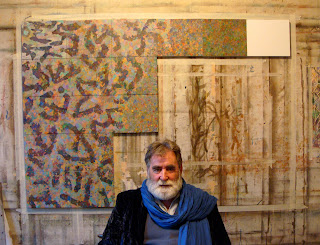
Tom Phillips
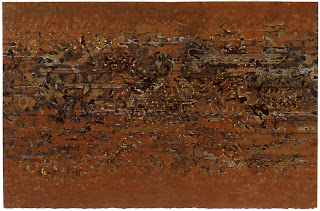
Song Of The Earth, 2002. Earth & acrylic medium on paper. h106cms x w160cms
In Princeton once more for the autumn though the trees this year on Einstein Drive are turning late. In any case I am not, as on my last visit, that Wordsworthian eccentric the often-spotted leaf-gatherer combing the institute's grounds for the choicest fallen foliage, the most rubified or rusted or gilded leaves.
This time I am more relaxedly looking for samples of earth with an idea in mind that Halting the Fall [see blog 19.10.06 + 16.11.06] which dealt with local beauty could be complemented by a work that spoke of the Institute for Advanced Study's international identity in that it attracts distinguished researchers and scholars from all over the world. This was in part provoked by seeing again a tantalising and mysteriously lit wall at the end of a long corridor but more so by the spectacle from my window of a soilmover at work creating a mighty mound of russet earth at the end of its track.
As the profile of this heap gradually took on an uncanny resemblance to that of Mt Ste Victoire I began to think it had something to do with the sculpture that I knew had been commissioned from Richard Long. I soon learned however that Richard's sculpture was in a concealed courtyard best viewed from the library of the Astrophysics building where I temporarily had my office. Oddly enough I have since become a semi official apologist for the piece, and have already given a requested seminar to the astrophysicists on its meaning and virtues in their mid morning coffee colloquium.
It seems strange to me that people who are used to dealing with events that happened before there was a when [in a place before there was a where] should be perplexed by a small and spikily elegant assemblage of exfoliated rock. I pointed out that the sculpture's first success was soon achieved by its provocation of such a discussion. We had some lively exchanges, along the inevitable lines that art argument is doomed to take, before they returned to simpler issues like what happens when a large black hole swallows a smaller one. I kept to myself the thought that celestial indigestion must result, culminating in a cosmic belch.
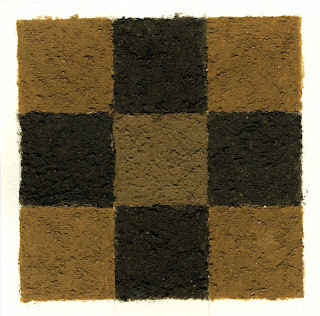
Princeton Earth Study, mud & acrylic medium 2007
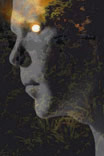
Coming up in the next month there will be two workshop performances of Heart of Darkness, a chamber opera of the Joseph Conrad novella composed by Tarik O'Regan to a libretto and design by TP.
The first on 9th November 8pm at the Wolfensohn Hall, Institute for Advanced Study, Princeton is a concert reading of scenes with Tarik O'Regan and TP in association with American Opera Projects. The performance is open to the public and tickets are free, but they should be reserved in advance. To request tickets or for further information about this event, please call (609) 734-8175 or visit the IAS website
The second concert reading will be on 11th November at American Opera Projects South Oxford Space, 138 S. Oxford Street, Brooklyn, New York, where Tarik O’Regan and Tom Phillips will take part in a panel discussion about the piece. For further information and to view an extract visit the Opera Projects website.
On the 5th November there will be a party at the Flowers gallery in New York for friends and patrons of American Opera Projects.
There are plans for a further performance in London next Spring in association with the Genesis Foundation.

Off to Princeton once more for a month of calm on Einstein Drive. I had hoped to reach the halfway stage in my painting but failed. Even the ground that seems to be covered contains quite a few provisional gestures that will have to be rehearsed again. Some tentative alterations have already been made, as may be noticed.
As the picture is now moving forward on all fronts each new manoeuvre questions the rhythm set up by the calligraphic elements as well as the overall territorial balance. Sitting and staring plays as large a part as the act of painting itself.
August and early September, empty of meetings and grim obligations, were perfect weeks for work, with only the distraction of an odd afternoon or so spent at the Oval watching cricket... it's nearly sixty years now since I sat there on the grass watching Bradman's sad, brief last innings.
Humument page 4 (click image to enlarge)
Meanwhile I have got behind with Humument pages. Here is the most recent. It will appear in my exhibition later in the month at Flowers New York but has been done in time to mark the show that opens next week at the Keiller Library of SNGMA Edinburgh. A Humument can serve as a book of reptrospective prophecy. When reworking p4 I was taken aback by finding 'nine eleven' emerging from Mallock’s 19th century text. I have joined this to two images from A Postcard Century that were indeed prophetic, featuring as they do the towers being attacked by Saturn and King Kong. One of the things I enjoy most is the 'only connect' aspect of linking one work of mine to another, so that all projects can be seen as parts of a single enterprise.
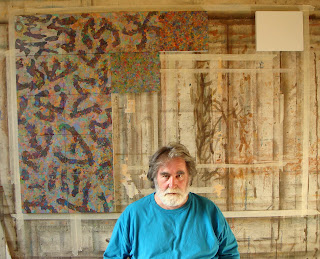
Now it seems possible to determine a size for the picture, indicated here by the optimistic placing of an unworked white panel to mark its top right hand corner. Also a border of masking tape helps to clarify the area on a messy studio wall, the historiated battlefield of many large pastel drawings and paintings in mud.
The need to pin down (or in this case pin up) the likely dimensions, comes from the old pictorial problem of the perilous centre, a Scylla and Charybdis passage which must be passed without stressing that tempting point of natural focus for the viewer. An overemphatic mark or strident clash of colour at this juncture (or a conspicuous absence of event) would make the whole image a vortex trapping the spectator's attention at its middle. In the West (following a habit of dealing with text) we read pictures from left to right as in the East they are scanned from top to bottom. In either case the eye must be urged to traverse the half way mark. That point as can be seen here (directly above the appropriately anxious artist's head) is now, in mid-September, not too far away.
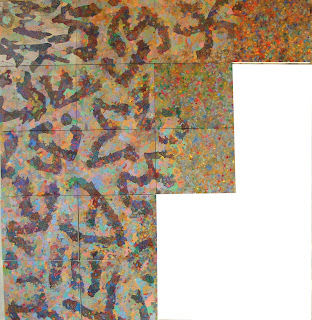
This was the state of play at the start of August. Probing each new panel is like exploring a dark and only half remembered room with a faulty torch.....
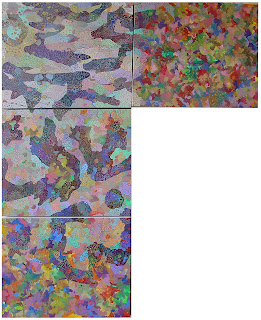
Probing into the unmapped territories beyond the edges of the initial panel was exciting. The first move with each panel was to create a field of inconclusive marks without reference to its neighbour; a space for the partially resolved shapes to reach out into and conquer, as in a territorial game. The main guiding systems were already present in Panel I, a dialogue of dark and light and a conversation between large calligraphic forms and the intricate ornamentation of which they were made and which they inhabited. My own tendency to over-clarify the boundaries would have to be fought - i.e. gritting my teeth to relax. The more general question of how large this work would be remained open.
tbc
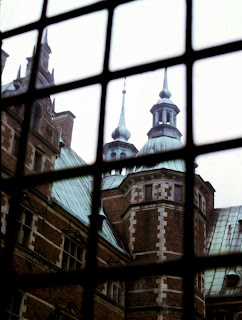
Emerging from the Panton Street Odeon after seeing The Seventh Seal again (I see it once every fifty years). I realise that I now have something in common with the knight (the amazing Max Von Sydow) and his squire (Gunnar Bjornstrand) - I will fail to reach the same destination ... since they are bound for Elsinore.
And I am emerging also from an exchange of messages between my Peckham studio and the very castle in which the story of the Gloomy Dane is set. The author of the official guide to Hamlet's home contacted me a year ago having heard of my work the Ghost Library (which came down this week from the walls of the Royal Academy). His enquiry sounded friendly and was accompanied by a copy of the interesting guidebook: he intimated that Elsinore might welcome a showing of my work when it was done; a cherished idea optimistically announced as a probability earlier in the blog.
What in fact ensued was the most frustratingly tedious correpondence I've ever entered into. Not only were my sometimes light-hearted exegeses of the work (was it Mao or Lenin who said you can't make a Hamlet without cracking jokes?) crushed by page after numbing page of wilfully obtuse pedantry, but it transpired that my correspondent lacked the authority to accept the work and moreover would not support any plan to show it in the castle at all.
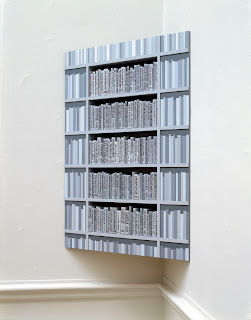
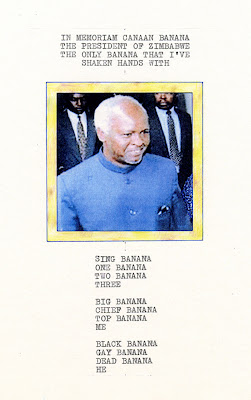
Meanwhile I have promises to keep. One is to make an image of a banana as a campaign contribution in support of Turps Banana an excellent quarterly in which painters write about painting...a non-flashy forum that is not, like so many art journals, a pimple of matter on a mound of promotional hype or a few bits of critical prose that serve to keep the adverts apart.
I told its co-editor Marcus Harvey that I'd only met one banana, the disgraced former President of Zimbabwe. I have, it so happens, a poor record in meeting world leaders. Disgrace is a common factor, since my roster includes Saddam Hussein, Robert Mugabe and Tony Blair. If Hillary Clinton gets elected you have been warned.
For some reason some kind of skipping rhyme came into my head to accompany Canaan Banana . I felt the need also to rescue my lovely Olivetti portable from too many years of neglect. How pleasurably physical is the bangy act of typewriting and how fine the font looks after acres of computerface.

